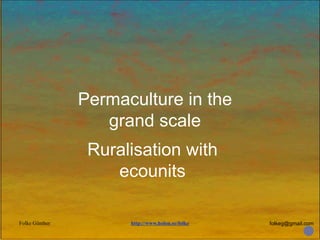
Permaculture Eco-Units Recycle Nutrients for Sustainable Rural Living
- 1. Permaculture in the grand scale Ruralisation with ecounits
- 4. Therefore, we need a lifeboat
- 5. Extraction horizons of phosphorus At higher energy price: ?? years 100 – 150 years At current energy price: Peak phosphorus
- 8. Balanced agriculture: Animals are fed with plants growing from their manure = about 80% recycling of nutrients PO 4 Feed Urine One hectare: Balanced agriculture
- 9. .. but 3-4 kg of the phosphorus (20%) is exported as food The 3-4 kg amounts to the P content of the excrements from 5 persons PO 4 Feed Urine Food Urine = 0,2 ha/pers One hectare: Limited group of people
- 10. .. these nutrients must be returned to close the cycle With source-separating toilets, these nutrients can be recycled PO 4 Feed Urine Food Urine PO 4 = 0,2 ha/pers One hectare: Local recycling system
- 13. Economy
- 14. Total energy investment: about 40.000 kWh / 4 pers Energy delivered to household: about 4.000 kWh/ 4 p. The energy economy of conventional food production Energy invested in agriculture: about 4.000 kWh/ 4 p. Energy invested by middlemen: about 36.000 kWh/ 4 p.
- 15. 60.000 SEK The economy of conventional food production 0 kr 15 000 kr 30 000 kr 60 000 kr Annual consumer cost for food (four person Swedish family) Payment to producer, less than 25% Trade, distribution and processing about 75% of the total price Producer cost (fuel, interests etc.) 80% of producer payment Producer salary, about 3.000 SEK (5% of consumer cost)
- 16. Assume a group of consumers subscribe for food from a local farmer
- 17. They will drive the industry out of the market by paying the double industrial price (half of the consumer price)
- 18. Expenses Salary Distribution and trade Because of the increased food diversity produced, the farmers’s expenses are assumed to increase with 50% ..but the remaining is the farmers salary, which will increase 400% The consumer cost for the food decrease with 50% 13.000 18.000 60.000 30.000 12.000 3.000 The economy of ecounit food production conventional ecounit 0 15 000 30 000 45 000 60 000
- 19. Total energy investment in food : about 8.000 kWh / 4 pers The energy economy of ecounit food production Energy invested in (conventional) agriculture: about 4.000 kWh/ 4 p. Energy invested local management: about 8.000 kWh/ 4 p.
- 20. Let’s hope that the consumers will use their saved money to invest in the agriculture… Cheaper food Saved money Lesser energy price vulnerability
- 22. The ruralisation scenario – start point In this scenario, the following is assumed: 4. They decide that, i nstead of building new houses on the same place as the old ones were torn down, they will build eco-units in the periphery of the town. At start point, the centre of the municipality has a population of 33 000 The periphery: 3 000 1. The city is inhabited by decision-makers who have the capacity to make far-sighted and strategic decisions 3. Furthermore, they understand that the city is not static, but dynamic. Old houses are t orn down and new are built. (The average life-time for a house is supposed to be 60 years, which gives the city a rate of change of 1,6%) 2 . They have the same knowledge of limiting resources, ecology and the rules for long-term survival as you.
- 23. Ruralisation – after 12 years The town center: 24 000 The periphery : 12 000 Groups of four Eco-units Each group is inhabited by 800 people Local parks replacing the old houses
- 24. Ruralisation – after 25 years The town : 12 000 The periphery : 24 000 Reversed ditching: Underground streams are brought to the surface Cleaner water
